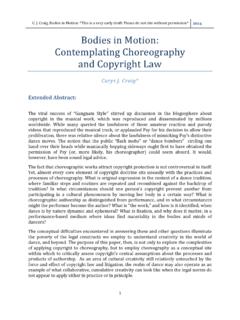Transcription of What Works in Community Policing - Berkeley Law
1 what Works in Community Policing ? A Best Practices Context for Measure Y Efforts November 2013 The Chief Justice Earl Warren Institute on Law and Social Policy University of California, Berkeley School of Law The Chief Justice Earl Warren Institute on Law & Social Policy at the UC Berkeley School of Law is a research and policy center with the mission of bridging the gap between academia and practice. As part of Berkeley Law, the Warren Institute leverages the intellectual capital of a world-class public university to produce high-quality data, action-oriented research, and evidence-based policy recommendations on many of society's most challenging issues. Resource Development Associates Resource Development Associates is a mission driven consulting firm founded in 1984 to promote the welfare of our communities by contributing to the effective functioning of public and non-profit health and human service systems.
2 To this end, we provide a suite of consulting services to Community -based non-profits and local, state and federal agencies. Please take the time to visit our web pages to learn more about us and the important services that we offer. bright Research Group bright Research Group helps public, private and non-profit agencies measure the difference they are making, maximize their ability to offer quality services, align their work to best practices and develop long-term strategies to transform systems and communities. Authored by Sarah Lawrence and Bobby McCarthy of the Warren Institute Contents Introduction .. 4 what is Community Policing ? .. 5 what are the Key Components of Community Policing ?
3 5 Organizational Transformation .. 6 Community Partnership .. 7 Problem Solving .. 9 Keys to Successful Community Policing .. 12 Common Challenges and Barriers to Success .. 12 Community Policing and Measure Y .. 12 In Alignment with Best Practices .. 13 Not in Alignment with Best Practices .. 13 Oakland Police Department: A Department in Flux .. 14 Measure Y as an Opportunity .. 15 References .. 16 Introduction In November 2004 Oakland voters passed the Violence Prevention and Public Safety Act, commonly referred to as Measure The stated, overarching goal of Measure Y is to improve public safety, with a particular focus on reducing violence involving Oakland youth. Revenues from the 10-year parcel tax support three components: violence prevention programs, Community Policing officers, and fire and paramedic services.
4 In addition, up to 3% of funding is set aside for an independent evaluation. This report, which is part of that evaluation effort, looks at Community Policing from a national perspective in terms of the generally agreed upon goals, principles, components, and strategies in the field of Policing . It summarizes what we know about Community Policing from a few decades of learning, research, and implementation efforts. It then examines the Community Policing components of Measure Y and the extent to which they are aligned with these best practices. In short, how do the Community Policing elements, as articulated in the 2004 resolution, generally measure up to what we know are the most effective components of Community Policing ?
5 The 10-year period for Measure Y sunsets in 2014 and City leaders and Oakland voters will need to decide the future of this public safety investment. This report aims to help provide a national context for those discussions and deliberations that is grounded in research and best practices. The goal is to provide various stakeholders a framework for strengthening Community Policing efforts in Oakland. Intended audiences include the Mayor, City Council members, Oakland Police Department (OPD) leadership, members of the Violence Prevention and Public Safety Oversight Committee, City residents, and Community -based organizations, among others. This assessment is based on a review of the social science research literature, including the seminal articles that are generally considered to be the foundations for what we know about Community Policing and the latest studies that have built upon that foundation.
6 In addition, it draws from publications by key organizations in the field of Policing such as the Department of Justice, Community Oriented Policing Services (COPS) Office, DOJ, Bureau of Justice Assistance, and the Police Executive Research Forum (PERF). It is worth noting that the City of Oakland is undergoing significant changes and reforms on several fronts, some of which are supported by external monitors and national experts including those related to the Negotiated Settlement Agreement and recommendations being put forward from the Bratton Group and Strategic Policy Partnership. Those efforts are relatively more prescriptive in nature. The purpose of this review is to provide a framework of the bigger picture principles and components of Community Policing in light of the fact that leaders and residents will be revisiting this significant public safety investment in the upcoming year.
7 1 Oakland City Council (2004). Resolution No. 78734 , Revised 7-20-04. what is Community Policing ? For the first half of the 20th century, police departments in most jurisdictions in the United States operated under what is generally referred to as a professional model of Policing . Under this model, local police departments were organized around strict hierarchical lines, utilized standardized operational protocols, and emphasized responding to serious crimes when they occurred. As social disorder and crime rates began to rise during the second half of the century, law enforcement and other municipal leaders began to re-examine the role of police departments in public safety management and craft reform efforts that sought to reduce crime through improved relationships and direct partnerships between citizens and police.
8 These efforts eventually coalesced around a new philosophy of law enforcement known as Community Policing , which stressed more direct officer involvement with local citizens, was organized around less rigid hierarchies and protocols, and attempted to address the root causes of neighborhood crime with the assistance of the larger Adoption of the Community Policing philosophy by local police departments occurred gradually throughout the 1970 s and 1980 s and by the early 1990 s, more and more cities were beginning to adopt Community Policing After decades of adoption at the local level, Community Policing was effectively endorsed by the federal government with the passage of the Violent Crime Control and Law Enforcement Act of 1994.
9 This bill authorized an initial six-year expenditure of $ billion in federal aid to support Community Policing efforts, and created the Office of Community Oriented Policing Services (COPS) to distribute and monitor this funding. Today, the COPS Office continues to operate Community Policing initiatives nationwide and distribute grant funds to localities to support those Increased funding and recognition of Community Policing success stories led to an explosion of its implementation in the following years. In 1994, only 20% of surveyed police departments nationally reported employing some elements of the Community Policing model, a figure which rose to 58% in a subsequent 1997 survey, and 68% by Community Policing remains the dominant local law enforcement philosophy in the United States today, with 81% of the nation s population being served by law enforcement agencies that have adopted Community Policing However, as will be discussed below, while Community Policing is generally considered the new norm in local law enforcement.
10 Departments structures and practices still vary considerably across jurisdictions and Community Policing still means different things to different people. what are the Key Components of Community Policing ? In general terms, Community Policing is not a program; it is not a set of activities; it is not a personnel designation. Rather, Community Policing is a law enforcement philosophy, a way of thinking about improving public safety. While there is a lack of standardization regarding specific terminology and strategies of Community Policing across cities, Community Policing efforts can generally be grouped into three broad 2 Diamond & Weiss (2009).












